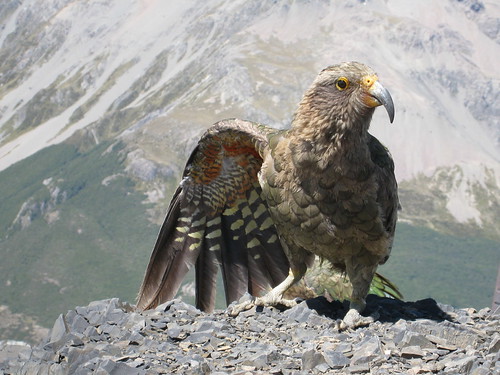 Kea, Avalanche Peak. Image by Rick CoxPesky kea are again bothering homeowners in Kaiteriteri and the message from authorities is that humans have to learn to co-exist with the curious birds.
Kea, Avalanche Peak. Image by Rick CoxPesky kea are again bothering homeowners in Kaiteriteri and the message from authorities is that humans have to learn to co-exist with the curious birds.
Last October four kea believed to have damaged solar panels, campervans and boats in the area were trapped at Bethany Park camp at Kaiteriteri and moved near Rainbow skifield but Department of Conservation biodiversity ranger Leigh Marshall said that was a "not a sustainable way of living with wildlife".
At the time, DOC biodiversity ranger Kate Steffens had said DOC was reluctant to move kea but in this case, they had "crossed a line in the sand".
Marshall said DOC had received a few calls in the past couple of weeks from Kaiteriteri residents advising the department that kea were back in the area although they have not been seen at Bethany Park since they were moved.
"There's definitely still the perception that we will just come and move them but that's not the case. We have to learn strategies of how we can live with them."
Next week the Kea Conservation Trust will make a presentation in Motueka on how to live with kea without conflict, which will also be a chance to learn more about the inquisitive birds and for people to share their experiences with kea.
Marshall said the Kea Conservation Trust decided to make the Nelson regional stop on the national roadshow in Motueka to be closer to the people dealing with populations of kea at Kaiteriteri and Marahau.
"Kea are neophilic - they love exploring anything new. They are attracted to human activity and belongings, and anything soft and pliable is of particular interest. Anything which provides a food reward is even more interesting", said Marshall.
"They are also the world's only mountain parrot, highly intelligent, and a nationally threatened species. Fewer than 5000 kea remain, found only in the South Island of New Zealand."
Tamsin Orr-Walker, chair of the Kea Conservation Trust, said she recognised that kea behaviour could be annoying.
"We work with communities to find solutions to these conflict issues. Simply making a few changes, such as putting away gear, cleaning up rubbish, leaving doors and windows closed, and never feeding kea can make it possible to live conflict free."
Kaiteriteri resident Jo Ryder resorted to chasing kea away with a hose last spring after they damaged her hot water cylinder, a boat cover and a trampoline. That is one of the techniques recommended by the Kea Conservation Trust but Ryder said the kea treated it as a game.
"As a landowner, the kea have all the rights and you've just got to live with it and if they damage anything, we have to pay for it. We inform people who rent our place not to leave food out and not to feed the kea but when we're talking about a campground, that's not realistic. At the end of the day we're meant to live alongside the kea but when people are getting the rubber around their windows eaten - how do you live with that?"
She said a similar meeting for Kaiteriteri residents last year had been informative but the bottom line was that having to deal with kea doing damage was likely to cost homeowners thousands.
It is illegal under the Wildlife Act for people to move or kill kea themselves.
The meeting will be at the Memorial Park pavilion at 7pm on June 24.